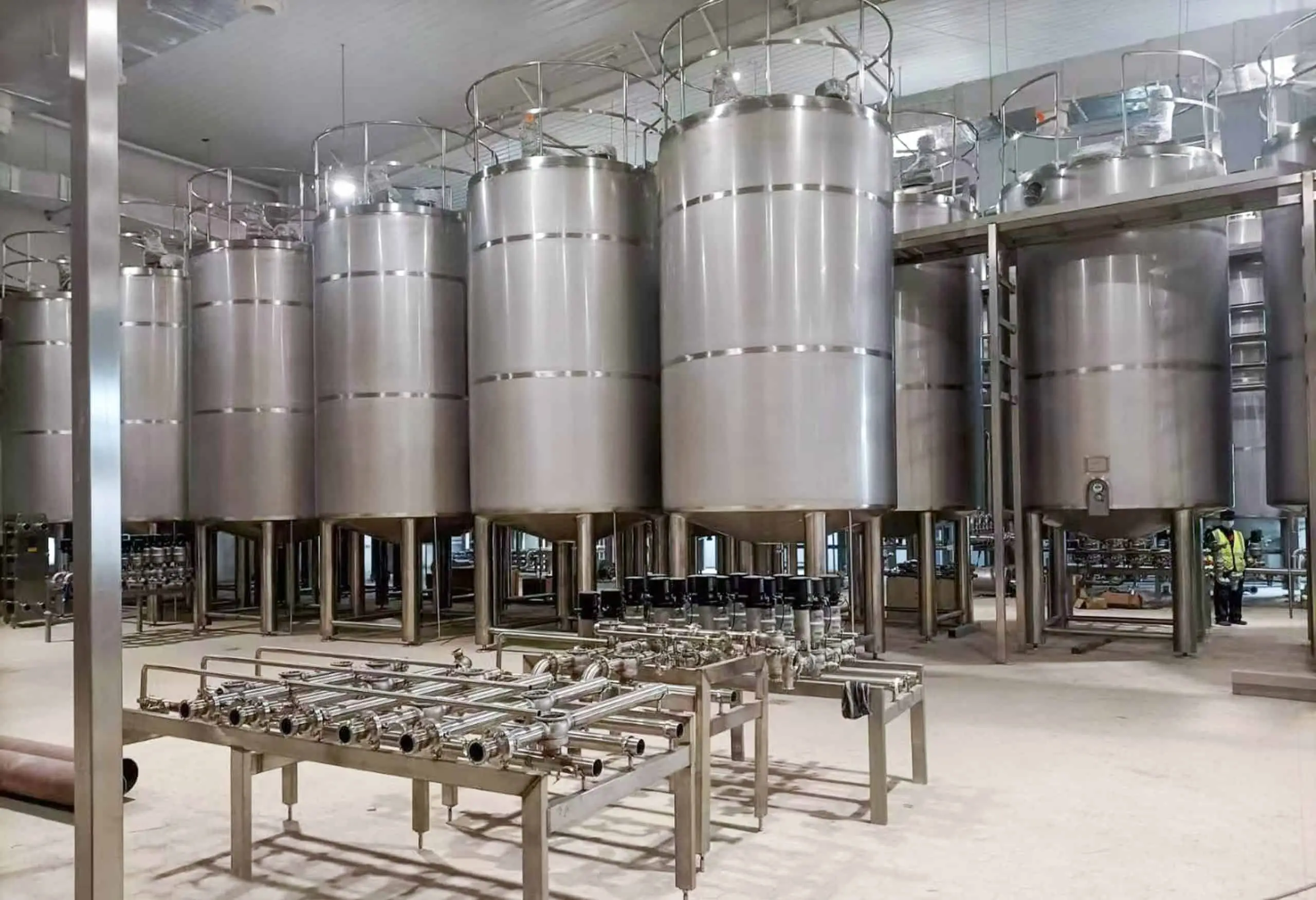مقدمة

في صناعة الأغذية، لا يعد الحفاظ على معايير النظافة الصارمة مجرد متطلب تنظيمي، بل يشكل أيضًا جانبًا أساسيًا لضمان سلامة المستهلك وجودة المنتج. تلعب معدات التنظيف في المكان (CIP) دورًا محوريًا في تحقيق هذه المعايير والحفاظ عليها بكفاءة وفعالية. تستكشف هذه المدونة بالتفصيل أهمية معدات التنظيف في المكان ومكوناتها وفوائدها التشغيلية ومعايير الصناعة وإرشادات التنفيذ العملي.
فهم تنظيف المعدات في مكانها
تم تصميم معدات التنظيف في المكان (CIP) لأتمتة عملية تنظيف المعدات الصناعية دون الحاجة إلى تفكيكها. تتضمن هذه الطريقة تداول محاليل التنظيف المتخصصة عبر الأنابيب والخزانات ومعدات المعالجة الأخرى لإزالة البقايا والكائنات الحية الدقيقة والمواد الملوثة الأخرى التي قد تؤثر على جودة المنتج أو سلامته.
مكونات أنظمة التنظيف في الموقع
يتكون نظام CIP النموذجي من عدة مكونات أساسية:
- الخزانات وتخزين المواد الكيميائية:مكان تخزين محاليل التنظيف والمنظفات والمطهرات.
- المضخات والصمامات:المسؤول عن توزيع سوائل التنظيف في جميع أنحاء النظام بمعدلات تدفق خاضعة للرقابة.
- المبادلات الحرارية:يستخدم لتسخين أو تبريد محاليل التنظيف حسب الحاجة لتحقيق فعالية التنظيف المثالية.
- أنظمة التحكم:لمراقبة وتنظيم معلمات عملية التنظيف في الموقع مثل درجة الحرارة والضغط ومعدلات التدفق.
- الأجهزة:بما في ذلك أجهزة الاستشعار والمقاييس لضمان الأداء السليم وتوفير البيانات اللازمة للتحكم في العملية والتحقق من صحتها.
أهمية تنظيف المعدات في مكانها
يعد الحفاظ على نظافة المعدات أمرًا بالغ الأهمية لمنع التلوث وضمان جودة المنتج والامتثال لقواعد سلامة الأغذية الصارمة. توفر أنظمة التنظيف المكاني العديد من المزايا الرئيسية مقارنة بأساليب التنظيف التقليدية:
- كفاءة:يقلل من وقت التوقف عن العمل عن طريق تنظيف المعدات في مكانها، مما يزيل الحاجة إلى التفكيك وإعادة التجميع.
- تناسق:يضمن تنظيفًا موحدًا لجميع المعدات، مما يقلل من التباين في فعالية التنظيف.
- أمان:يقلل من خطر التعرض للمواد الكيميائية الضارة والمسببات للأمراض أثناء عمليات التنظيف اليدوي.
- ضمان الجودة:يساعد في الحفاظ على سلامة المنتج من خلال تقليل مخاطر التلوث المتبادل ونقل النكهة بين الدفعات.
- توفير التكاليف التشغيلية:يقلل من تكاليف العمالة المرتبطة بعمليات التنظيف اليدوي ويقلل من استخدام المياه والمواد الكيميائية.
دراسة حالة: فعالية التنظيف المكاني في مصانع تجهيز الأغذية
على سبيل المثال، أظهرت دراسة مقارنة أجريت في مصانع تجهيز الأغذية أن أنظمة التنظيف في المكان تقلل بشكل كبير من مستويات التلوث الميكروبي ووقت التوقف التشغيلي مقارنة بأساليب التنظيف اليدوية. وتترجم هذه الكفاءة إلى تحسين القدرة الإنتاجية وتقليل مخاطر سحب المنتجات بسبب مشاكل التلوث.
معايير الصناعة واللوائح
يعد الالتزام بمعايير الصناعة واللوائح أمرًا بالغ الأهمية لضمان فعالية وسلامة المعدات النظيفة في مرافق معالجة الأغذية. وقد وضعت الهيئات التنظيمية مثل إدارة الغذاء والدواء ووزارة الزراعة الأمريكية إرشادات صارمة لإجراءات التنظيف وممارسات الصرف الصحي.
مقارنة المعايير العالمية للمعدات النظيفة في مكانها
قد تختلف المعايير واللوائح المتعلقة بمعدات التنظيف في الموقع وإجراءات التنظيف باختلاف المناطق:
| معيار | وصف |
|---|---|
| إرشادات إدارة الغذاء والدواء | تحديد المتطلبات المحددة لإجراءات التنظيف والمواد الكيميائية المعتمدة للاستخدام في معدات معالجة الأغذية. |
| المعايير الأوروبية | تحديد المعايير الخاصة بتصميم وبناء وأداء معدات التنظيف المكاني لضمان النظافة وسلامة الغذاء. |
| شهادة الأيزو | توفير معايير دولية لنظم إدارة الجودة ومعايير النظافة في إنتاج الأغذية. |
تنفيذ خطة فعالة CIP برنامج

يتطلب التنفيذ الناجح لبرنامج CIP التخطيط الدقيق والتنفيذ والصيانة المستمرة لضمان الأداء الأمثل والامتثال للمتطلبات التنظيمية.
قائمة مراجعة لتنفيذ برنامج الاستثمار الرأسمالي بشكل فعال
- تحضير:اغسل المعدات جيدًا بالماء لإزالة البقايا السائبة قبل بدء دورة التنظيف في المكان.
- تنظيف:قم بتوزيع حلول التنظيف المناسبة من خلال نظام التنظيف في المكان عند درجات حرارة ومعدلات تدفق محددة لضمان التنظيف الشامل لجميع الأسطح.
- الشطف:اشطف المعدات جيدًا بالماء النظيف لإزالة مواد التنظيف المتبقية وتطهير الأسطح.
- تصديق:التحقق من فعالية عملية التنظيف من خلال الفحص البصري أو اختبار المسحة الميكروبية أو غيرها من الطرق المعتمدة لضمان الامتثال لمعايير النظافة.
خاتمة
معدات التنظيف في المكان (CIP) يعد التنظيف الفعّال أمرًا لا غنى عنه في صناعة الأغذية للحفاظ على معايير عالية من النظافة، وضمان جودة المنتج، والتخفيف من المخاطر المرتبطة بالتلوث. من خلال الالتزام بلوائح الصناعة وتنفيذ برامج التنظيف الفعّالة، يمكن لمصنعي الأغذية الحفاظ على ثقة المستهلك، والامتثال للمتطلبات التنظيمية، وتحسين الكفاءة التشغيلية.
التعليمات
س: ما هي الفوائد الأساسية لاستخدام تنظيف المعدات في مكانها?
أ: توفر المعدات النظيفة في مكانها مزايا كبيرة مثل تقليل وقت التوقف عن العمل، ونتائج التنظيف المتسقة، وتحسين السلامة، وتعزيز جودة المنتج.
س: كم مرة ينبغي تنظيف المعدات في مكانها يتم تفتيشها؟
أ: يجب فحص المعدات النظيفة في مكانها بانتظام بناءً على توصيات الشركة المصنعة وأنماط الاستخدام لضمان الأداء السليم والنظافة.
س: ما هي مواد التنظيف المستخدمة عادة في نظيف في مكانه الأنظمة؟
ج: تختلف عوامل التنظيف المستخدمة في أنظمة التنظيف في المكان وفقًا لنوع البقايا المراد إزالتها وتوافق المواد المستخدمة في المعدات. وتشمل العوامل الشائعة المنظفات القلوية والحمضية والإنزيمية المصممة خصيصًا لتلبية احتياجات التنظيف المحددة.

